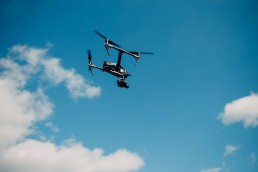Navigating the skies: Drones and urban mobility
How can drones help cities become safer, more efficient, and sustainable? During Mobility Day 2023, experts in urban mobility and drone technology gathered for a panel discussion on this topic, addressing the transformative potential and challenges of integrating drones into urban transportation systems.
In the evolving urban environments of today, drones are rapidly becoming integral to modern urban transport strategies. The panel – featuring representatives from RISE, The City of Stockholm, Ericsson Drone Mobility, Region Stockholm, ATS Bromma and LFV – emphasized that drones have the potential to redefine a broad range of services. From efficient package deliveries to life-saving medical supplies like automated defibrillators, drones offer a flexible and eco-friendly alternative to traditional transport methods. With the right infrastructure, it’s anticipated that drone transport could replace up to 75% of express deliveries in the future.
However, innovation doesn’t come without its challenges. Regulatory constraints present a significant bottleneck, especially around permits and urban airspace ownership. Navigating these legal frameworks involves coordination between different layers of governance – from local municipalities to EU level. The panel also underscored behavioral challenges, noting that public perceptions, concerns and acceptance of drones in urban spaces play a vital role in their successful integration. There’s need for ongoing conversations, not just among cities, innovators, and policymakers, but also with the public to streamline regulations and create a supportive setting for drone integration into urban mobility.
On the technical side, allowing drones to operate beyond the pilot’s visual range brings up some specific challenges. These include not just limited control range but also concerns in other areas like data security and public safety, especially in high-density urban areas. During the panel discussion, it was noted that advancements in 5G connectivity are essential for improving the reliability and safety of drone operations in these settings. This technological progress, in turn, requires close cooperation between drone companies and mobile network providers to fine-tune network performance specifically for drones.
In conclusion, tackling these challenges calls for a collaborative, multi-disciplinary approach. The path forward lies in aligning not just on regulations but also on infrastructure, financing, and, not least, public acceptance. By establishing a shared vision and mutual understanding among all stakeholders, the acceleration of drone deployment in cities becomes not a question of “if” but “when”. As cities like Stockholm aim for ambitious sustainability goals, drone integration stands as a powerful means to achieve them.
Thanks to our panelists for contributing to this discussion:
Rasmus Lundqvist of RISE
Erik Levander of The City of Stockholm Transport Department
Anders Carlsson of ATS Bromma, LFV
Fredrik Flyrin of Ericsson Drone Mobility
Fredrik Engströmer of Region Stockholm
Karolina Pamp of Kista Science City
Learn more about ongoing activities in the area of Drones and Urban air mobility.
Reach out to Karolina if you want to talk more!


Related Articles
December 9, 2025
Understanding online risks: Lisa Kaati’s research at DSV in Kista
The boundaries of conflict are shifting. Today, national security isn’t just…




